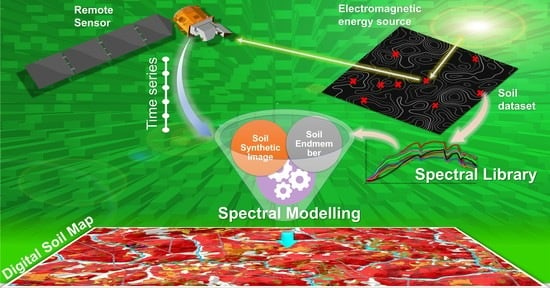Digital Soil Mapping Using Multispectral Modeling with Landsat Time Series Cloud Computing Based
Abstract
:1. Introduction
2. Materials and Methods
2.1. Study Area
2.2. Soil Characterization and Classification
2.3. Data Processing
2.3.1. Statistical Analysis
2.3.2. Spectroscopy and Compilation of the Soil Spectral Library
2.3.3. Landsat Time Series and Synthetic Soil/Rock Image
2.4. Soil Spectral Modeling and DSM Generation
Validation of Soil Spectral Mapping
3. Results
3.1. Soil Characteristics
3.1.1. Statistical Analysis
3.1.2. Soil Classification
3.1.3. Soils Spectral Behavior
3.2. Synthetic Soil/Rock Image Analysis
3.3. Mapped Area Accounting
3.4. Validation of Spectral Mixing Models
4. Discussion
4.1. Performance of Spectral Modeling
4.2. Digital Soil Map
5. Conclusions
Author Contributions
Funding
Institutional Review Board Statement
Informed Consent Statement
Data Availability Statement
Acknowledgments
Conflicts of Interest
References
- Genú, A.M.; Roberts, D.; Demattê, J.A.M. The use of multiple endmember spectral mixture analysis (MESMA) for the mapping of soil attributes using ASTER imagery. Acta Sci. 2013, 35, 377–386. [Google Scholar] [CrossRef] [Green Version]
- Chabrillat, S.; Ben-Dor, E.; Cierniewski, J.; Gomez, C.; Schmid, T.; van Wesemael, B. Imaging spectroscopy for soil mapping and monitoring. Surv. Geophys. 2019, 40, 361–399. [Google Scholar] [CrossRef] [Green Version]
- Reatto, A.; Martins, E.S.; Farias, M.F.R.; Silva, A.V.; Carvalho, O.A., Jr. Mapa Pedológico Digital: SIG Atualizado do Distrito Federal Escala 1:100.000 e uma Síntese do Texto Explicativo; (Documentos, 120); Embrapa Cerrados: Planaltina, Brazil, 2004; p. 31. [Google Scholar]
- Ben-Dor, E.; Chabrillat, S.; Demattê, J.A.M.; Taylor, G.R.; Hill, J.; Whiting, M.L.; Sommer, S. Using imaging spectroscopy to study soil properties. Remote Sens. Environ. 2009, 113, 38–55. [Google Scholar] [CrossRef]
- Diek, S.; Schaepman, M.E.; Jong, R. Creating multi-temporal composites of airborne imaging spectroscopy data in support of digital soil mapping. Remote Sens. 2016, 8, 906. [Google Scholar] [CrossRef] [Green Version]
- Lacerda, M.P.C.; Demattê, J.A.M.; Sato, M.V.; Fongaro, C.T.; Gallo, B.C.; Souza, A.B. Tropical texture determination by proximal sensing using a regional spectral library and its relationship with soil classification. Remote Sens. 2016, 8, 701. [Google Scholar] [CrossRef] [Green Version]
- Fongaro, C.T.; Demattê, J.A.M.; Rizzo, R.; Safanelli, J.L.; Mendes, W.S.; Dotto, A.C.; Vicente, L.E.; Franceschini, M.H.D.; Ustin, S.L. Improvement of clay and sand quantification based on a novel approach with a focus on multispectral satellite images. Remote Sens. 2018, 10, 1555. [Google Scholar] [CrossRef] [Green Version]
- Gallo, B.C.; Demattê, J.A.M.; Rizzo, R.; Safanelli, J.L.; Mendes, W.S.; Lepsch, I.F.; Sato, M.V.; Romero, D.J.; Lacerda, M.P.C. Multi-temporal satellite images on topsoil attribute quantification and the relationship with soil classes and geology. Remote Sens. 2018, 10, 1571. [Google Scholar] [CrossRef]
- Rogge, D.; Bauer, A.; Zeidler, J.; Mueller, A.; Esch, T.; Heiden, U. Building an exposed soil composite processor (SCMaP) for mapping spatial and temporal characteristics of soils with Landsat imagery (1984–2014). Remote Sens. Environ. 2018, 205, 1–17. [Google Scholar] [CrossRef] [Green Version]
- Poppiel, R.R.; Lacerda, M.P.C.; Demattê, J.A.M.; Oliveira, M.P.; Gallo, B.C.; Safanelli, J.L. Soil class map of the Rio Jardim watershed in Central Brazil at 30 meter spatial resolution based on proximal and remote sensed data and MESMA method. Data Brief. 2019, 25, 104070. [Google Scholar] [CrossRef]
- Poppiel, R.R.; Lacerda, M.P.C.; Demattê, J.A.M.; Oliveira, M.P.; Gallo, B.C.; Safanelli, J.L. Pedology and soil class mapping from proximal and remote sensed data. Geoderma 2019, 348, 189–206. [Google Scholar] [CrossRef]
- Demattê, J.A.M.; Dotto, A.C.; Paiva, A.F.S.; Sato, M.V.; Dalmolin, R.S.D.; Araújo, M.S.B.; Silva, E.B.; Nanni, M.R.; ten Caten, A.; Noronha, N.C.; et al. The Brazilian Soil Spectral Library (BSSL): A general view, application and challenges. Geoderma 2019, 354, 113793. [Google Scholar] [CrossRef]
- Liu, J.; Xie, J.; Han, J.; Wang, H.; Sun, J.; Li, R.; Li, S. Visible and near-infrared spectroscopy with chemometrics are able to predict soil physical and chemical properties. J. Soil Sediment. 2020, 20, 2749–2760. [Google Scholar] [CrossRef]
- Coblinski, J.A.; Giasson, É.; Demattê, J.A.M.; Dotto, A.C.; Costa, J.J.F.; Vašát, R. Prediction of soil texture classes through different wavelength regions of reflectance spectroscopy at various soil depths. Catena 2020, 189, 104485. [Google Scholar] [CrossRef]
- USGS. Landsat Data Users Handbook; EROS Center: Sioux Falls, SD, USA, 2019; 196p.
- Demattê, J.A.M.; Fongaro, C.T.; Rizzo, R.; Safanelli, J.L. Geospatial Soil Sensing System (GEOS3): A powerful data mining procedure to retrieve soil spectral reflectance from satellite images. Remote Sens. Environ. 2018, 212, 161–175. [Google Scholar] [CrossRef]
- Poppiel, R.R.; Lacerda, M.P.C.; Safanelli, J.L.; Rizzo, R.; Oliveira, M.P., Jr.; Novais, J.J.; Demattê, J.A.M. Mapping at 30 m Resolution of Soil Attributes at Multiple Depths in Midwest Brazil. Remote Sens. 2019, 11, 2905. [Google Scholar] [CrossRef] [Green Version]
- Köppen, W. Klassifikation der Klimate nach Temperatur, Niederschlag und Jahresablauf (Classification of climates according to temperature, precipitation and seasonal cycle). Petermanns Geogr. Mitt. 1918, 64, 193–203. [Google Scholar]
- Castro, K.B.; Lima, L.A.S. Atlas do Distrito Federal; CODEPLAN: Brasília, Brazil, 2020. [Google Scholar]
- Lacerda, M.P.C.; Barbosa, I.O. Relações pedomorfológicas e distribuição de pedoformas na estação ecológica Águas Emendadas, Distrito Federal. Rev. Bras. Cienc. Solo 2012, 36, 709–721. [Google Scholar] [CrossRef] [Green Version]
- Pinto, M.N. Caracterização geomorfológica do Distrito Federal. In Cerrado: Caracterização, Ocupação e Perspectivas; Pinto, M.N., Ed.; UnB—SEMATEC: Brasília, DF, Brazil, 1994. [Google Scholar]
- Sano, E.E.; Rodrigues, A.A.; Martins, E.S.; Bettiol, G.M.; Bustamante, M.M.C.; Bezerra, A.S.; Couto, A.F., Jr.; Vasconcelos, V.; Schüler, J.; Bolfe, E.L. Cerrado ecoregions: A spatial framework to assess and prioritize Brazilian savanna environmental diversity for conservation. J. Environ. Manag. 2019, 232, 818–828. [Google Scholar] [CrossRef] [PubMed]
- Freitas-Silva, F.H.; Campos, J.E.G. Geologia do Distrito Federal. In Inventário Hidrogeológico e dos Recursos Hídricos Superficiais do Distrito Federal; Barros, J.C.B., Ed.; CAESB: Brasília, Brazil, 1987. [Google Scholar]
- Schad, P.; van Huysteen, C.; Michéli, E. World Reference Base for Soil Resources 2014: International Soil Classification System for Naming Soils and Creating Legends for Soil Maps; FAO: Rome, Italy, 2014. [Google Scholar]
- Ditzler, C.; Scheffe, K. (Eds.) Soil Survey Manual Agriculture. In USDA Handbook 18; Government Printing Office: Washington, DC, USA, 2017. [Google Scholar]
- Santos, H.G.; Jacomine, P.K.T.; Anjos, L.H.C.; Oliveira, V.A.; Lumbreras, J.F.; Coelho, M.R.; Almeida, J.A.; Araújo Filho, J.C.; Oliveira, J.B.; Cunha, T.J.F. Sistema Brasileiro de Classificação de Solos; Embrapa Solos: Rio de Janeiro, Brazil, 2018. [Google Scholar]
- USDA. Illustrated Guide to Soil Taxonomy (Version 2); USDA: Lincoln, NE, USA, 2015.
- Schoeneberger, P.J.; Wysocki, D.A.; Benham, E.C. Field Book for Describing and Sampling Soils; Version 3.0; USDA: Lincoln, NE, USA, 2012.
- Soil Survey Staff. Soil Survey Field and Laboratory Methods Manual; USDA, Natural Resources Conservation Service: Washington, DC, USA, 2014.
- Teixeira, P.C.; Donagemma, G.K.; Fontana, A.; Teixeira, W.G. Manual de Métodos de Análise de Solo; Embrapa Solos: Rio de Janeiro, Brazil, 2017. [Google Scholar]
- Munsell Color. Munsell Soil Color Book; Munsell Color: Grand Rapids, MI, USA, 2015. [Google Scholar]
- Bouyoucos, G.J. Hydrometer method improved for making particle size analyses of soils 1. Agron. J. 1962, 54, 464–465. [Google Scholar] [CrossRef]
- Chang, C.-W.; Laird, D.A.; Mausbach, M.J.; Hurburgh, C.R. Near-infrared reflectance spectroscopy—Principal components regression analyses of soil properties. Soil Sci. Soc. Am. J. 2001, 65, 480–490. [Google Scholar] [CrossRef] [Green Version]
- Ogen, Y.; Zaluda, J.; Francos, N.; Goldshleger, N.; Ben-Dor, E. Cluster-based spectral models for a robust assessment of soil properties. Geoderma 2019, 340, 175–184. [Google Scholar] [CrossRef]
- ASD Inc. ASD Fieldspec® 4: The Industry-Leading Portable Device for Field Spectroscopy, 6th ed.; ASD Inc.: Falls Church, VA, USA, 2019. [Google Scholar]
- Romero, D.J.; Ben-Dor, E.; Demattê, J.A.M.; Souza, A.B.; Vicente, L.E.; Tavares, T.R.; Martello, M.; Strabeli, T.F.; Barros, P.P.S.; Fiorio, P.R.; et al. Internal soil standard method for the Brazilian soil spectral library: Performance and proximate analysis. Geoderma 2018, 312, 95–103. [Google Scholar] [CrossRef]
- Demattê, J.A.M.; Bellinaso, H.; Romero, D.J.; Fongaro, C.T. Morphological Interpretation of Reflectance Spectrum (MIRS) using libraries looking towards soil classification. Sci. Agric. 2014, 71, 509–520. [Google Scholar] [CrossRef]
- Scheinost, A.C.; Chavernas, A.; Barrón, V.; Torrent, J. Use and limitations of second-derivative diffuse reflectance spectroscopy in the visible to near-infrared range to identify and quantify Fe oxide minerals in soils. Clays Clay Miner. 1998, 46, 528–536. [Google Scholar] [CrossRef]
- Roberts, D.A.; Gardner, M.; Church, R.; Ustin, S.; Scheer, G.; Green, R.O. Mapping chaparral in the Santa Monica Mountains using multiple endmember spectral mixture models. Remote Sens. Environ. 1998, 65, 267–279. [Google Scholar] [CrossRef]
- Crabbé, A.H.; Jakimow, B.; Somers, B.; Roberts, D.A.; Halligan, K.; Dennison, P.; Dudley, K. Viper Tools Software. 2019. Available online: http://tools2019.innopolis.ru/ (accessed on 31 January 2021).
- Congalton, R.G.; Green, K. Assessing the Accuracy of Remotely Sensed Data Principles and Practices, 2nd ed.; CRC Press: Boca Raton, FL, USA, 2013. [Google Scholar]
- Landis, J.R.; Koch, G.G. The measurement of observer agreement for categorical data. Biometrics 2011, 33, 159–174. [Google Scholar] [CrossRef] [Green Version]
- Sousa, D.M.G.; Lobato, E. Cerrado: Correção do Solo e Adubação; Embrapa: Brasília, Brazil, 2004. [Google Scholar]
- Rizzo, R.; Demattê, J.A.M.; Lepsch, I.F.; Gallo, B.C.; Fongaro, C.T. Digital soil mapping at local scale using a multi-depth Vis-NIR spectral library and terrain attributes. Geoderma 2016, 274, 18–27. [Google Scholar] [CrossRef]
- Baptista, G.M.M.; Teobaldo, D. WorldView-2 sensor for the detection of hematite and goethite in tropical soils. Pesq. Agrop. Brasileira 2017, 52, 1192–1202. [Google Scholar] [CrossRef] [Green Version]
- Demattê, J.A.M.; Safanelli, J.L.; Poppiel, R.R.; Rizzo, R.; Silvero, N.E.Q.; de Sousa Mendes, W.; Bonfatti, B.R.; Dotto, A.C.; Salazar, D.F.U.; de Oliveira Mello, F.A.; et al. Bare Earth’s surface spectra as a proxy for soil resource monitoring. Sci. Rep. 2020, 10, 4461. [Google Scholar] [CrossRef]
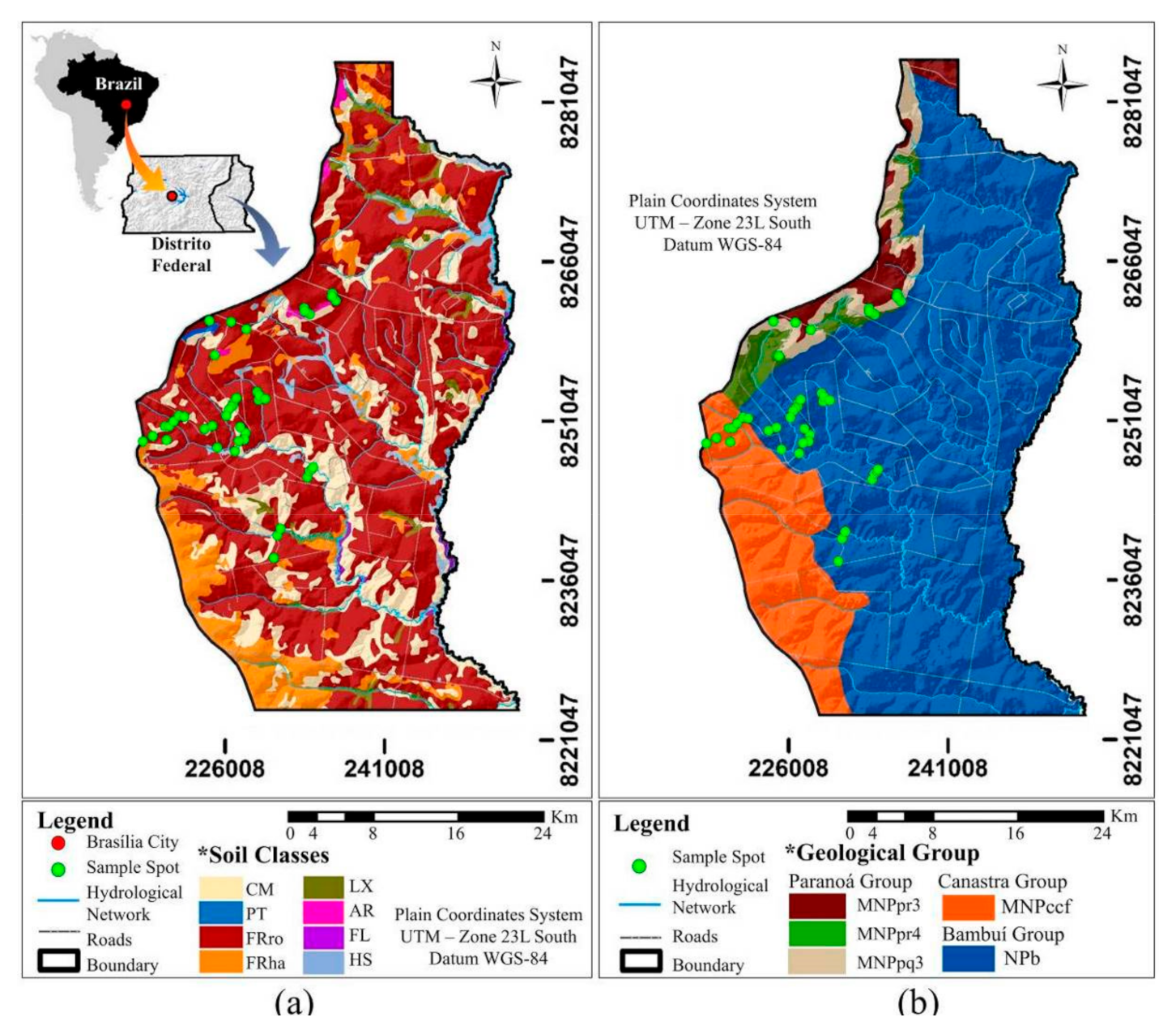

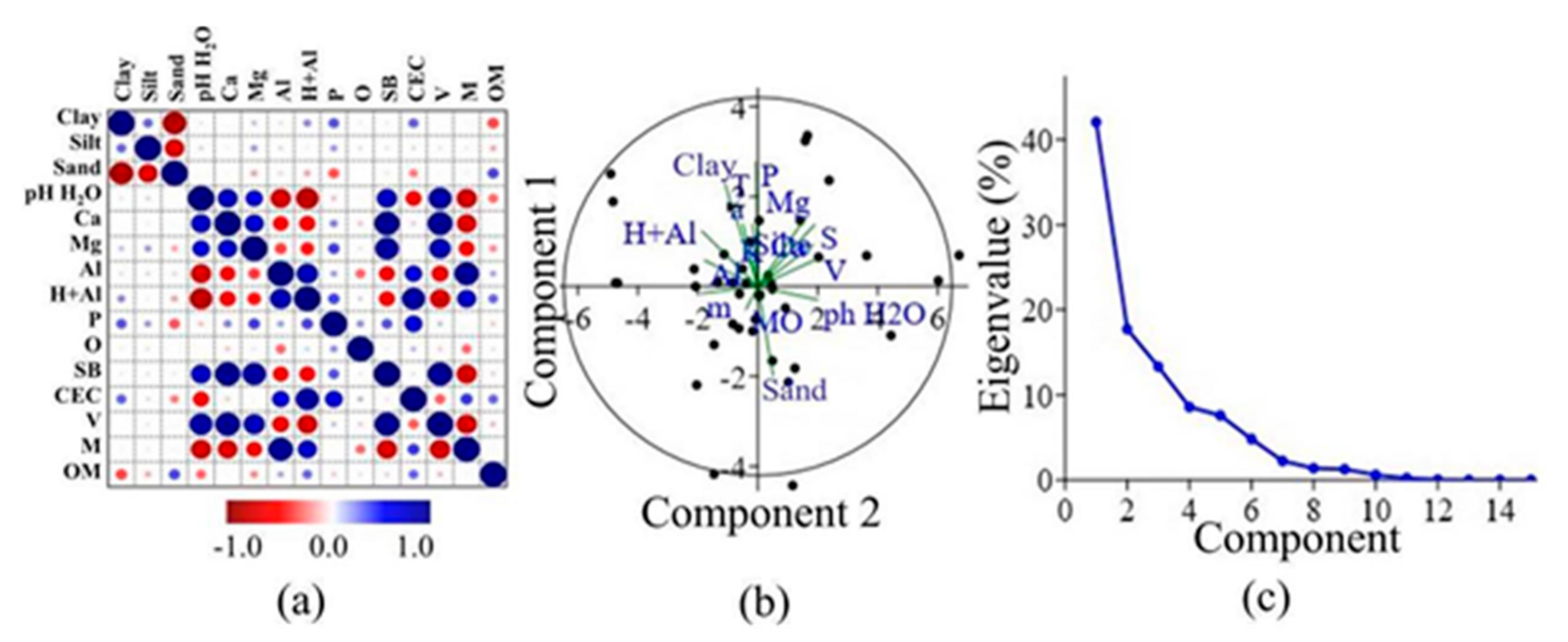


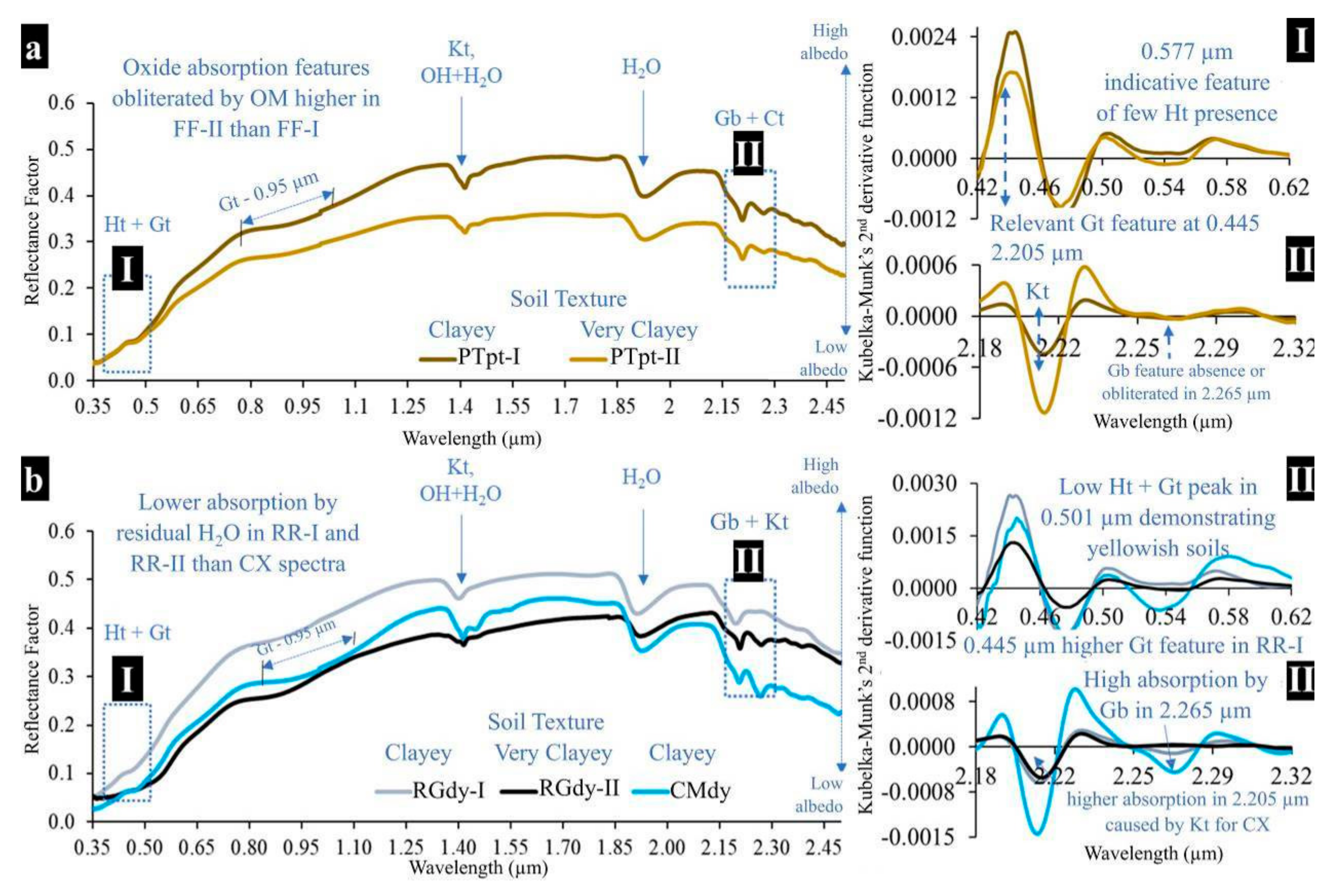

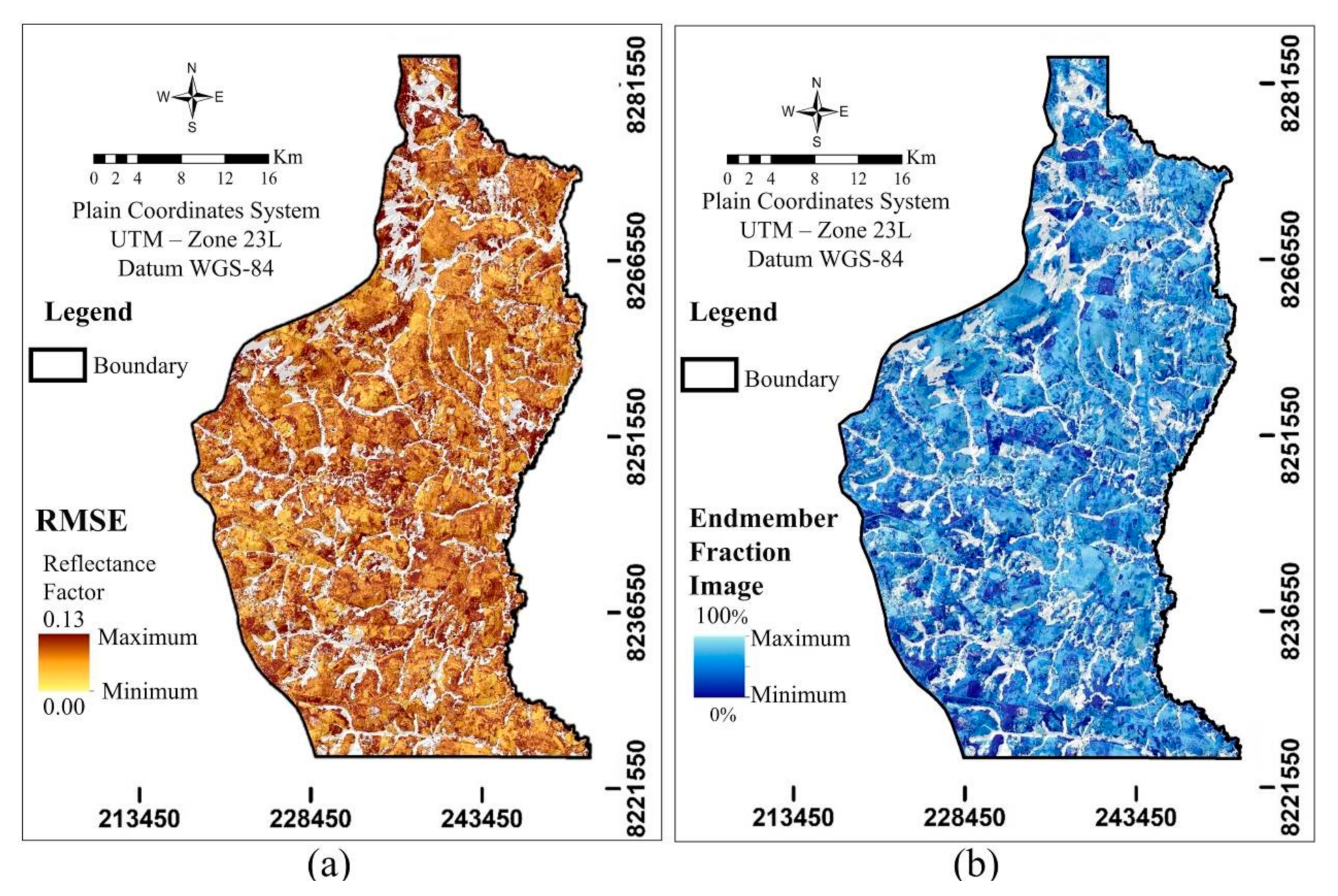

| Attributes/Parameters | Clay | Silt | Sand | pH | Al3+ | SB | CEC | V | m | 5 OM |
|---|---|---|---|---|---|---|---|---|---|---|
| g·Kg−1 | ------ Cmolc·dm−3------ | ------ % ------ | g·Kg−1 | |||||||
| Surface Horizons (0–20 cm) | ||||||||||
| Average | 504.7 | 197.4 | 298.0 | 4.9 | 1.2 | 1.9 | 9.0 | 22.3 | 37.8 | 34.1 |
| Standard error | 31.3 | 20.1 | 40.3 | 0.1 | 0.2 | 0.2 | 0.3 | 2.5 | 4.4 | 1.1 |
| Median | 590.7 | 159.4 | 190.8 | 4.9 | 1.0 | 1.6 | 8.7 | 18.5 | 31.0 | 31.5 |
| Mode | 792.2 | 87.1 | 120.7 | 5.0 | 0.4 | 3.9 | 14.6 | 6.2 | 89.0 | 44.0 |
| SD | 202.7 | 130.4 | 261.3 | 0.6 | 1.2 | 1.3 | 2.1 | 16.4 | 28.5 | 7.4 |
| Variance | 41,102.1 | 17,008.2 | 68,259.4 | 0.4 | 1.4 | 1.7 | 4.3 | 267 | 814 | 55 |
| Kurtosis | −0.2 | −1.1 | 0.4 | 2.5 | 0.5 | 1.2 | 1.0 | 3.3 | −0.9 | −1.4 |
| Asymmetry | −0.8 | 0.4 | 1.4 | 0.7 | 1.2 | 1.2 | 1.0 | 1.7 | 0.6 | 0.4 |
| Range | 747.3 | 442.5 | 863.5 | 3.1 | 4.1 | 5.3 | 8.8 | 76.3 | 89.0 | 24.0 |
| Minimum | 44.9 | 10.5 | 67.3 | 3.7 | 0.0 | 0.4 | 5.9 | 4.1 | 0.0 | 22.0 |
| Maximum | 792.2 | 453.0 | 930.8 | 6.8 | 4.1 | 5.7 | 14.6 | 80.4 | 89.0 | 46.0 |
| Count | 42.0 | 42.0 | 42.0 | 42.0 | 42.0 | 42.0 | 42.0 | 42.0 | 42.0 | 42.0 |
| CL (90.0%) | 52.6 | 33.9 | 67.8 | 0.2 | 0.3 | 0.3 | 0.5 | 4.2 | 7.4 | 1.9 |
| Attributes/Parameters | Clay | Silt | Sand | pH | Al3+ | SB | CEC | V | m | 5 OM |
|---|---|---|---|---|---|---|---|---|---|---|
| g·Kg−1 | ------ Cmolc·dm−3------ | ------ % ------ | g·Kg−1 | |||||||
| Surface Horizons (0–20 cm) | ||||||||||
| Average | 553.1 | 204.7 | 242.2 | 5.1 | 1.3 | 0.7 | 4.9 | 15.9 | 39.8 | 20.0 |
| Standard error | 29.8 | 19.1 | 35.6 | 0.0 | 0.3 | 0.1 | 0.3 | 1.4 | 5.1 | 1.3 |
| Median | 607.5 | 189.2 | 144.7 | 5.0 | 0.4 | 0.6 | 4.5 | 13.9 | 31.0 | 19.0 |
| Mode | 748.2 | 107.1 | 144.7 | 4.9 | 0.1 | 0.4 | 4.9 | 8.0 | 17.0 | 20.0 |
| SD | 193.2 | 123.9 | 230.6 | 0.3 | 1.7 | 0.4 | 2.2 | 8.9 | 32.9 | 8.2 |
| Variance | 37,325.8 | 15,361.9 | 53,194.3 | 0.1 | 2.9 | 0.2 | 4.8 | 79.8 | 1079.3 | 66.9 |
| Kurtosis | 0.0 | −1.1 | 1.1 | 7.3 | 1.7 | 4.1 | 8.2 | 7.3 | −1.4 | −0.3 |
| Asymmetry | −1.0 | 0.5 | 1.5 | 1.9 | 1.5 | 2.0 | 2.3 | 2.4 | 0.5 | 0.6 |
| Range | 715.3 | 386.6 | 845.1 | 1.6 | 6.5 | 1.7 | 12.2 | 44.3 | 93.0 | 29.0 |
| Minimum | 69.2 | 48.8 | 36.9 | 4.6 | 0.0 | 0.4 | 2.3 | 7.7 | 0.0 | 8.0 |
| Maximum | 784.6 | 435.3 | 882.0 | 6.2 | 6.5 | 2.1 | 14.5 | 52.0 | 93.0 | 37.0 |
| Count | 42.0 | 42.0 | 42.0 | 42.0 | 42.0 | 42.0 | 42.0 | 42.0 | 42.0 | 42.0 |
| CL (90.0%) | 50.2 | 32.2 | 59.9 | 0.1 | 0.4 | 0.1 | 0.6 | 2.3 | 8.5 | 2.1 |
| SiBCS | Soil Taxonomy | WRB FAO | T | S | EM |
|---|---|---|---|---|---|
| Latossolo Vermelho Distrófico típico | Rhodic Acrustox | Dystric Rhodic Ferralsol | clayey | 5 | FRro-I |
| v. clay. | 2 | FRro-II | |||
| Latossolo Vermelho-Amarelo distrófico típico | Typic Acrustox | Dystric Haplic Ferralsol | l. clay. | 5 | FRha-I |
| clayey | 6 | FRha-II | |||
| Plintossolo Pétrico concrecionário típico | Petroferric Ustox | Dystric Petric Plinthosol | clayey | 4 | PTpt-I |
| v. clay. | 4 | PTpt-II | |||
| Plintossolo Háplico distrófico típico | Typic Plinthaquox | Dystric Haplic Plintosol | v. clay. | 2 | PTha |
| Neossolo Regolítico distrófico típico | Typic Ustorthent | Dystric Regosol | clayey | 2 | RGdy-I |
| v. clay. | 4 | RGdy-II | |||
| Gleissolo Háplico Tb distrófico típico | Typic Fluvaquents | Dystric Haplic Gleysol | clayey | 2 | GLha |
| Organossolo Háplico hêmico típico | Typic Haplohemist | Hemic HaplicHistosol | clayey | 1 | HSha |
| Cambissolo Háplico Tb distrófico típico | Oxic Dystrustepts | Dystric Rhodic Cambisol | clayey | 3 | CMdy |
| Neossolo Quartzarênico órtico típico | Typic Quartzipzament | Dystric Rhodic Arenosol | sandy | 2 | ARdy |
| Authors | Study Area | Time Series | Percentage (%) |
|---|---|---|---|
| [5] | Swiss Plateau | 1984–2016 | 43 |
| [7] | Brazil, Southeast | 1984–2011 | 68 |
| [8] | Brazil, Southeast | 1984–2017 | 53 |
| [9] | Germany | 1984–2014 | 26 |
| [10] | Brazil, Midwest | 1984–2018 | 74 |
| [16] | Brazil, Southeast | 1984–2018 | 68 |
| [17] | Brazil, Midwest | 1984–2019 | 100 * |
| [46] | Worldwide | 1985–2015 | 34 |
| Mapping Unit | Soil Class on WRB System [24] | Area | |
|---|---|---|---|
| Hectares | Percentage (%) | ||
| FRro-I | Dystric Rhodic Ferralsol (Clayic) | 53,754 | 50.3 |
| FRro-II | Dystric Rhodic Ferralsol (Very Clayic) | 15,149 | 14.2 |
| FRha-I | Dystric Haplic Ferralsol (Loam-Clayic) | 5051 | 4.7 |
| FRha-II | Dystric Haplic Ferralsol (Clayic) | 12,301 | 11.5 |
| PTpt-I | Dystric Petric Plinthosol (Clayic) | 4844 | 4.5 |
| PTpt-II | Dystric Petric Plinthosol (Very Clayic) | 10,252 | 9.6 |
| RGdy-I | Dystric Regosol (Clayic) | 1424 | 1.3 |
| RGdy-II | Dystric Regosol (Very Clayic) | 3,223 | 3.0 |
| CMdy | Dystric Haplic Cambisol (Clayic) | 828 | 0.8 |
| Subtotal | 106,828 | 80.6 | |
| Unmapped | 25,697 | 19.4 | |
| Total | 132,525 | 100.0 | |
| Soil Classes | Field Truth | Total | UA | OE | |||||||||
|---|---|---|---|---|---|---|---|---|---|---|---|---|---|
| A | B | C | D | E | F | G | H | I | % | ||||
| Digital soil map | A | 79 | 5 | 2 | 2 | 1 | 0 | 0 | 0 | 1 | 90 | 88 | 12 |
| B | 8 | 38 | 0 | 0 | 0 | 0 | 0 | 0 | 0 | 46 | 83 | 17 | |
| C | 1 | 0 | 17 | 2 | 0 | 0 | 0 | 1 | 1 | 22 | 77 | 23 | |
| D | 2 | 1 | 6 | 27 | 7 | 4 | 1 | 2 | 0 | 50 | 54 | 46 | |
| E | 1 | 2 | 0 | 7 | 23 | 3 | 1 | 1 | 1 | 39 | 59 | 41 | |
| F | 1 | 0 | 0 | 4 | 0 | 25 | 0 | 1 | 0 | 31 | 81 | 19 | |
| G | 0 | 0 | 0 | 2 | 5 | 2 | 19 | 1 | 0 | 29 | 66 | 34 | |
| H | 0 | 0 | 0 | 1 | 0 | 0 | 1 | 12 | 0 | 14 | 86 | 14 | |
| I | 0 | 0 | 0 | 1 | 1 | 0 | 0 | 0 | 5 | 7 | 71 | 29 | |
| Total | 92 | 46 | 25 | 46 | 37 | 34 | 22 | 18 | 8 | 245 | |||
| PA | % | 86 | 83 | 68 | 59 | 62 | 74 | 86 | 67 | 63 | |||
| CE | 14 | 17 | 32 | 41 | 38 | 26 | 14 | 33 | 38 | ||||
| κ% | 74.6951 | Validation points | 328 | ||||||||||
Publisher’s Note: MDPI stays neutral with regard to jurisdictional claims in published maps and institutional affiliations. |
© 2021 by the authors. Licensee MDPI, Basel, Switzerland. This article is an open access article distributed under the terms and conditions of the Creative Commons Attribution (CC BY) license (http://creativecommons.org/licenses/by/4.0/).
Share and Cite
Novais, J.J.; Lacerda, M.P.C.; Sano, E.E.; Demattê, J.A.M.; Oliveira, M.P., Jr. Digital Soil Mapping Using Multispectral Modeling with Landsat Time Series Cloud Computing Based. Remote Sens. 2021, 13, 1181. https://doi.org/10.3390/rs13061181
Novais JJ, Lacerda MPC, Sano EE, Demattê JAM, Oliveira MP Jr. Digital Soil Mapping Using Multispectral Modeling with Landsat Time Series Cloud Computing Based. Remote Sensing. 2021; 13(6):1181. https://doi.org/10.3390/rs13061181
Chicago/Turabian StyleNovais, Jean J., Marilusa P. C. Lacerda, Edson E. Sano, José A. M. Demattê, and Manuel P. Oliveira, Jr. 2021. "Digital Soil Mapping Using Multispectral Modeling with Landsat Time Series Cloud Computing Based" Remote Sensing 13, no. 6: 1181. https://doi.org/10.3390/rs13061181






